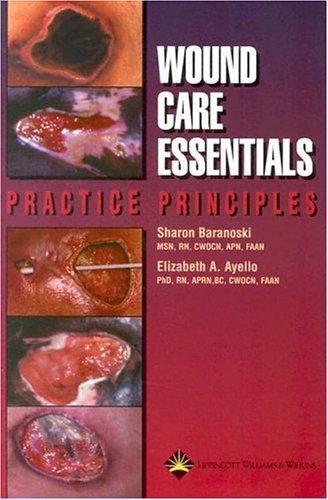Picture 1 of 1

Stock photo

Picture 1 of 1

Stock photo

Wound Care Essentials : Practice Principals by Springhouse Publishing Company Staff, Sharon Baranoski and Elizabeth A. Ayello (2003, Trade Paperback)

baystatebooks (41644)
99.1% positive feedback
Price:
$7.19
Free shipping
Returns:
Condition:
You are purchasing a Good copy of 'Wound Care Essentials: Practice Principles'. Condition Notes: The book is in good condition with all pages and cover intact, including the dust jacket if originally issued.
Oops! Looks like we're having trouble connecting to our server.
Refresh your browser window to try again.
About this product
Product Identifiers
PublisherLippincott Williams & Wilkins
ISBN-101582552746
ISBN-139781582552743
eBay Product ID (ePID)2839723
Product Key Features
Number of Pages432 Pages
Publication NameWound Care Essentials : Practice Principals
LanguageEnglish
Publication Year2003
SubjectEmergency Medicine, Nursing / Medical & Surgical, Nursing / General
TypeTextbook
AuthorSpringhouse Publishing Company Staff, Sharon Baranoski, Elizabeth A. Ayello
Subject AreaMedical
FormatTrade Paperback
Dimensions
Item Weight1587.3 Oz
Item Length9.2 in
Item Width6.1 in
Additional Product Features
Intended AudienceScholarly & Professional
LCCN2003-013185
Dewey Edition21
IllustratedYes
Dewey Decimal617.1
Table Of ContentPart One: Wound Care Concepts1. Quality of life and ethical issues2. Legal aspects of wound care3. Regulation and wound care4. Skin: An essential organ5. Acute and chronic wound healing6. Wound Assessment7. Wound bioburden8. Wound debridement9. Wound treatment options10. Nutrition and wound care11. Seating, positioning, and support surfaces12. Pain management and woundsPart Two: Wound Classifications and Management Strategies13. Pressure ulcers14. Vascular ulcers15. Diabetic foot ulcers16. Sickle cell ulcers17. Wounds in special populations18. Complex wounds19. Atypical wounds20. Wound care: Where we were, where we are, where we're going
SynopsisThis comprehensive yet concise wound care handbook was written by two outstanding wound care specialists, with contributions from more than 15 well-respected experts in the field. All aspects of wound care are covered: wound healing, wound assessment, and treatment options for all types of wounds. There is an emphasis on nutrition and quality of life for patients with chronic wounds, and a full chapter is devoted to pain associated with wounds and wound care. The legal and regulatory aspects associated with skin integrity are explored. The unusual wounds that result from malignant ulcers, vasculitis, pyoderma gangrenosum, and calciphylaxis are covered, as well as the wound care needs of special population groups such as older adults, children, spinal cord injury patients, and HIV-AIDS patients. More than 100 illustrations, checklists, tables, recurring icons, and flowcharts provide easy access to essential information, and an 16-page full-color insert illustrates the healing process and types of wounds. Supportive research and references follow each chapter., This comprehensive yet concise wound care handbook was written by two outstanding wound care specialists, with contributions from more than 15 well-respected experts in the field. All aspects of wound care are covered: wound healing, wound assessment, and treatment options for all types of wounds. There is an emphasis on nutrition and quality of life for patients with chronic wounds, and a full chapter is devoted to pain associated with wounds and wound care. The legal and regulatory aspects associated with skin integrity are explored. More than 100 illustrations, checklists, tables, recurring icons, and flowcharts provide easy access to essential information, and an 16-page full-color insert illustrates the healing process and types of wounds. Supportive research and references follow each chapter.
LC Classification NumberRD94.W655 2003
All listings for this product
Ratings and Reviews
Most relevant reviews
- Feb 04, 2019
Good
Good bookVerified purchase: YesCondition: Pre-owned



























